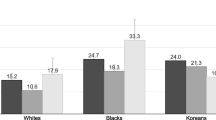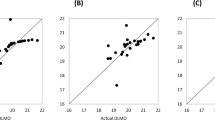Abstract
Circadian rhythm is essential for living beings. This rhythm regulates sleeping and waking patterns, hormone production, eating habits, digestion, and body temperature in humans and other animals. Prolonged use of Light at Night (LatN) has become a factor that can confuse biological clocks. In our research, we utilized ANOVA to perform feature selection and classification algorithms to explore the potential correlation between night-time light exposure and medical surgeon students’ weight. Our findings revealed that incorporating LatN exposure data resulted in enhanced classification outcomes. With this additional information, and not including BMI and height as features, the classifier was better equipped to distinguish between those who are overweight/obese compared to when only the students’ weight was considered.
Access this chapter
Tax calculation will be finalised at checkout
Purchases are for personal use only
Similar content being viewed by others
References
U.S. Department of Health and Human Services: Circadian rhythms. National Institute of General Medical Sciences. https://nigms.nih.gov/education/fact-sheets/Pages/circadian-rhythms.aspx. Accessed 4 Sep 2023
Arble, D.M., Bass, J., Laposky, A.D., Vitaterna, M.H., Turek, F.W.: Circadian timing of food intake contributes to weight gain. Obesity (Silver Spring) 17, 2100–2102 (2009)
Fonken, L.K., Workman, J.L., Walton, J.C., Weil, Z.M., Morris, J.S., et al.: Light at night increases body mass by shifting the time of food intake. Proc. Natl. Acad. Sci. U.S.A. 107, 18664–18669 (2010)
Salgado-Delgado, R.C., Saderi, N., Basualdo Mdel, C., Guerrero-Vargas, N.N., Escobar, C., Buijs, R.M.: Shift work or food intake during the rest phase promotes metabolic disruption and desynchrony of liver genes in male rats. PLOS ONE 8(4), e60052 (2013)
Brainard, G.C., Rollag, M.D., Hanifin, J.P.: Photic regulation of melatonin in humans: ocular and neural signal transduction. J. Biol. Rhythms 12(6), 537–546 (1997)
Markwald, R.R., et al.: Impact of insufficient sleep on total daily energy expenditure, food intake, and weight gain. Proc. Natl. Acad. Sci. 110(14), 5695–5700 (2013)
McFadden, E., Jones, M.E., Schoemaker, M.J., Ashworth, A., Swerdlow, A.J.: The relationship between obesity and exposure to light at night: cross-sectional analyses of over 100,000 women in the Breakthrough Generations Study. Am. J. Epidemiol. 180(3), 245–250 (2014)
Koo, Y.S., et al.: Outdoor artificial light at night, obesity, and sleep health: cross-sectional analysis in the KoGES study. Chronobiol. Int. 33(3), 301–314 (2016). https://doi.org/10.3109/07420528.2016.1143480
Danilenko, K.V., Mustafina, S.V., Pechenkina, E.A.: Bright light for weight loss: results of a controlled crossover trial. Obes. Facts 6, 28–38 (2013)
Reid, K.J., Santostasi, G., Baron, K.G., Wilson, J., Kang, J., Zee, P.C.: Timing and intensity of light correlate with body weight in adults. PLoS ONE 9(4), e92251 (2014)
Karlsson, B., Knutsson, A., Lindahl, B.: Is there an association between shift work and having a metabolic syndrome? Results from a population based study of 27 485 people. Occup. Environ. Med. 58(11), 747–752 (2001)
Author information
Authors and Affiliations
Corresponding author
Editor information
Editors and Affiliations
Rights and permissions
Copyright information
© 2024 The Author(s), under exclusive license to Springer Nature Switzerland AG
About this paper
Cite this paper
Sánchez-Sánchez, C., Mateos-Papis, A.P., Guerrero-Vargas, N.N., Ángeles-Castellanos, A.M., Escobar, C. (2024). Feature Selection and Classification for Searching Light at Night Exposure and Students’ Weight Relationship. In: Calvo, H., Martínez-Villaseñor, L., Ponce, H. (eds) Advances in Soft Computing. MICAI 2023. Lecture Notes in Computer Science(), vol 14392. Springer, Cham. https://doi.org/10.1007/978-3-031-47640-2_17
Download citation
DOI: https://doi.org/10.1007/978-3-031-47640-2_17
Published:
Publisher Name: Springer, Cham
Print ISBN: 978-3-031-47639-6
Online ISBN: 978-3-031-47640-2
eBook Packages: Computer ScienceComputer Science (R0)




